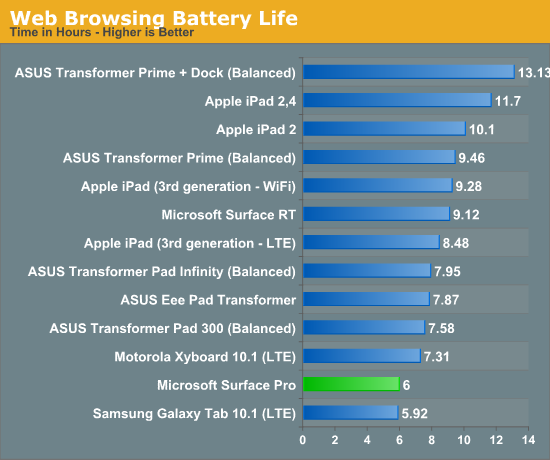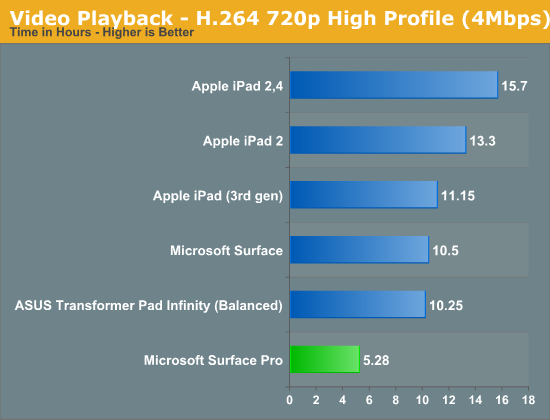Microsoft Surface Pro Review
by Anand Lal Shimpi on February 5, 2013 9:00 PM ESTBattery Life: The Downside
Despite having an integrated 42 Wh battery (similar in size to the 3rd and 4th gen iPads with Retina Display), battery life is a real sore spot for Surface Pro. Haswell is really designed to drive platform power down to very low levels, which should help close the gap between ARM/Atom based tablets and Core based tablets. Unfortunately, Haswell for tablets won’t hit until the third quarter of this year, which forced Microsoft to use Ivy Bridge.
In our tablet benchmarks, I never saw Surface Pro break the 6 hour mark on a single charge. In most cases I’d expect to see 5 - 6 hours out of Surface Pro in light, tablet usage. Video playback was especially disappointing as Surface Pro managed to use more power here than during our web browsing battery life test. I suspect this might have to do with the relative power efficiency of Ivy Bridge's video decoder. It'll be interesting to see how Haswell does in this department.


I also put Surface Pro through some of our new notebook battery life tests for 2013, and here it didn’t fare too bad. I only have Acer’s 13-inch S7 to compare to but Microsoft managed 3.85 hours in our medium workload compared to sub-3 hours for the larger Ultrabook:
| Windows 8 Notebook Battery Tests | ||
| Battery Test | Acer Aspire S7 (13-inch) | Microsoft Surface Pro |
| AnandTech 2013 Light | 4.00 hours | 5.2 hours |
| AnandTech 2013 Medium | 2.88 hours | 3.85 hours |
This is easily the biggest disappointment with Surface Pro. You just won’t get the all day battery life you do with an ARM based tablet out of this design. I expect Microsoft will have a solution to this problem with Haswell, but not until the end of the year.
Charging
Surface Pro retains the same large, magnetic power connector as Surface RT. In fact, Surface RT’s power adapter will still charge Surface Pro. The Pro model does however come with its own 48W adapter. It’s a nice looking, but large and still fairly traditional two piece power supply (brick + detachable wall cable). There’s no sophisticated cable management other than a tiny hook to help keep the device end of the cable together. One neat feature is the power adapter does feature an integrated USB port for charging your smartphone.
Under max charging load the power supply will draw around 27W at the wall. Microsoft included a 48W unit in order to be able to charge and power the device without slowing down charge time. It took me 2.692 hours to charge Surface Pro from completely empty to 100% with no additional power draw at the wall. The quick charge time is pretty nice and about the only reprieve here when talking about Surface Pro's battery.
I did notice something odd with the first power supply Microsoft sent me. When charging through my power meter, I picked up some interference in the capacitive touch screen itself resulting in around 10% of my taps not being recognized. Microsoft supplied another power supply that seemed to resolve the issue.













228 Comments
View All Comments
amrs - Wednesday, February 6, 2013 - link
I'm also wondering why the SSD benchmark showed only throughput? No 4k random access or access time tests?jack.fxx - Wednesday, February 6, 2013 - link
Surface Pro has 5 times greater performance than competing ARM tablets with half battery life.nangryo - Wednesday, February 6, 2013 - link
Considering cellular cell draws more power. I think you should separate the result of the wifi test and cellular test. Because makes the Galaxy Tab chart below Surface whilst it is using cellular connection makes it a bit inaccuratemaximumGPU - Wednesday, February 6, 2013 - link
can someone block this douche who's been polluting a lot of AT's threads?milli - Wednesday, February 6, 2013 - link
After reading this review, I have to conclude that Intel is ahead of ARM in regards to power efficiency on every front. Before this review, it was obvious that Clover Trail is competitive to the current ARM offerings on power usage and speed. And it's soon to be upgraded with the Silvermont core and 22nm.But Intel's i5 ULV seems to be better at performance/watt too. >5x faster while offering half the battery life. Even on a TDP level compared to Exynos 5 it's twice the power (8W vs 17W) while offering >4x the performance on the cpu front and at least 2-3x the performance on the GPU.
With Haswell and 22nm Atoms coming, it's seems ARM's stand against Intel is going to be more short lived than many believed.
LetsGo - Wednesday, February 6, 2013 - link
In your dreams, the Nexus 10 drives a much higher resolution then the surface pro and is the first iteration of A15's. ARM chips will undercut Intel's and deliver just as good performance because the real heavy work is done in the GPU.Watch Intel's share price drop in the coming years.
Netscorer - Wednesday, February 6, 2013 - link
Your conclusion is wrong. Clover Trail may have matched ARM power consumption but is still below the par on performance and is completely pathetic in GPU performance. To add insult to injury, it is priced substantially higher then ARM chips, so good luck seeing it in many mobile devices.Ivy Bridge is the top dog in performance but is still far from being optimized for power consumption. Haswell will (we all hope) change that but again, at much much higher prices then ARM design. When you have a CPU alone cost $250, forget about building budget tablets around it.
kyuu - Thursday, February 7, 2013 - link
What? Clover Trail is faster than any ARM SoC except for A15 -- and A15s use more power than Clover Trail.powerarmour - Wednesday, February 6, 2013 - link
$899 for a 64GB SSD with only 23GB free space... Give me a break...amdwilliam1985 - Wednesday, February 6, 2013 - link
$499 for 16GB with only 13GB free space... what the heck...Consumers should spend 2x$499 to get 26GB free space, haha this way they can beat surface pro in terms of non-removable space, lol.
On the other hand, feel free to insert SD card, USB flash, USB 3.0 external, NAS and etc...
What does the $499 offer you? They'll accuse you of stealing mp3, mp4, mp5 or whatever else they can accuse you of stealing. Yesterday they're telling you that you're holding it wrong, today they're calling you using the device the wrong way, I guess tomorrow they'll just call you stupid plain and clear so it's dummy proof ;)